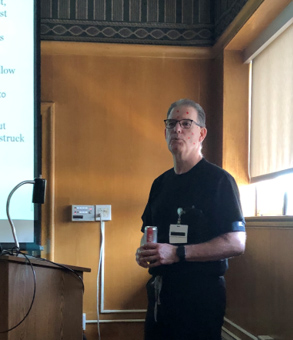Mercy Day: June 12, 2019 Emergency Medicine Conference Recap by Dr. Karima Sajadi
8:00 am Case conference by Dr. Matt Ognibene
Intern in "hot seat": Dr. Alex Mercado
Senior "life line": Dr. Melvin Thomas
CC: Unresponsive, found down
Heat-related emergencies
Physiologic response to heat:
1. Blood vessel dilation (skin)
2. Increased sweat production
3. Decreased heat production
4. Behavioral heat control
When any of these methods are compromised or overwhelmed, people are at risk for heatstroke.
Excessive heat is directly toxic to cells and results in release of inflammatory cytokines. When the temp > 108F (42C), enzymes stop working and oxidative phosphorylation is uncoupled.
Definition: Temp > 40 and CNS dysfunction.
Exertional heat stroke:
Young, healthy
Athletes, military recruits
Risk factorsL high ambient temp and high humidity, lack of acclimatization, poor physical fitness, obesity, dehydration, clothing/equipment/protective gear
Non-exertional (classic) heat stroke:
Elderly, comorbidities, physical disability, polypharmacy, meds (anticholienrgics, diuretics, beta-blockers, Ca channel blockers, etc), substance abuse.
Gradual onset – hours to days
Mortality 21-63%
Clinical features:
Mild: Rash, miliaria, heat edema, muscle cramps, heat syncope
Heat exhaustion: 38-40C, dehydration, N/V, weakness, syncope, confusion is mild and transient
Heat stroke: Temp >40C + persistent CNS dysfunction
Heat injures all organs via:
- Direct thermal injury
- Poor organ perfusion
- Hypercoagulability with micro- and macro thrombosis
- Severe metabolic derangements
CNS:
AMS, agitated delirium, ataxia, seizures, cerebral edema, posturing
Heart: sinus tachycardia, hypotension, dysrhythmias, conduction disturbances, high-output heart failure, myocardial ischemia or infarction
Lungs: aspiration, bronchospasm, non-cardiogenic pulmonary edema/ARDS, pulmonary infarction/hemorrhage
Liver: abnormal LFTs, acute liver failure, coagulopathy
Bowel: intestinal ischemia/infarction, GI bleeding
Kidneys: AKI, rhabdo, metabolic acidosis
Vasculature: hypotension, thrombocytopenia, DIC, uncontrolled bleeding, compartment syndrome
Initial resuscitation:
Start cooling immediately!!!!
ABCs: resuscitate before intubation, use Roc instead of Sux
Volume resuscitation – hypotension, volume depletion
Avoid vasopressors (may use Dopamine/Dobutamine)
Exposure: remove all clothing, put rectal probe for continuous monitoring
Cooling: rapid and early
Target goal temp is 102F (39C) to avoid overshooting
No role for ASA/Ibuprophen/Tylenol/Dantrolene
Evaporative/convection cooling:
Tepid water and fan blowing warm air, preferred in elderly patients. Not the fastest way to cool down.
Complications: shivering (use benzoes)
Makkah cooling unit
Immersion cooling:
Fully unclothed, ice bath, very fast and effective(1C per 5 min), preferred for healthy and exertional heat strokes
Complications: Shivering, labor intensive, safety is not well-established
Intravascular cooling: central line with balloons circulating cool fluids, used for TTM
Complications: DIC
Adjuvant cooling:
Ice packs to axillae/groin/neck/hands
Cold water lavage
Cooling blankets
Cold saline
Prognosis:
High mortality (21-63%), 20% will have irreversible brain damage
Factors for badness: anuria, coma, cardiopulmonary arrest
DDX for hyperpyrexia:
Conclusions:
Start cooling right away/asap
Be aggressive – goal < 102F
Continuous rectal temp monitoring
Consider your DDx
Don't use Levophed
Don't use antipyretics

9:00 am Measles by Dr. Phil Mead
We are in the middle of measles epidemics
1912 In USA all MDs were mandated to report measles
1954 Dr. Thomas Peebles isolated the measles virus
2000 Virus was eradicated in USA reportedly
Measles has no zoonotic reserve, so it is completely eradicable
Complications:
Diarrhea
OM
Pneumonia
Encephalitis – brain damage, hearing loss
Subacute sclerosing pan-encephalitis
Spread by "anti-vaxxers"
Most people in USA who contracted measles, were unvaccinated
All states allow medical exemptions
Most states allow religious exemptions
MMR vaccine
USA has the most number of unvaccinated kids (> 2 millions)
Measles = Rubeola
Paramyxovirus
Incubation 7-21 days
Rash after 14 days of exposure, but communicable 4 days prior to rash appearance
One of the most contagious virus
Only one serotype exists
Invades URT, spread to regional LNs and the rest of body
High F
Cough
Coryza
Conjunctivites
Then rash starts on forehead then spread down and out. Reddish macupopapular, then becomes confluent
Koplik's spots – bluish-whitish spots on buccal mucosa and soft palate
Measles does not have vesicles (unlike chickenpox)
Measles rash is not itchy (unlike chickenpox)
Very high fever, very sick (unlike rubella/German measles)
Not pink rash (like in Rubella)
No Forchheimer's spots = soft-palate petechiae (like in Rubella)
Testing:
Call 877.724.3258 in PA
Throat or nasopharyngeal swab
Serum sample
Urine sample
Treatment:
MMR vaccine within 72 hours of exposure can prevent measles
Ig 0.5 ml/kg, max dose 15 ml for high-risk non-immune patients within 6 days of exposure
Vitamin A one dose on the day of Dx and one dose the 2nd day
Measles is #1 cause of blindness in the world
Vaccine:
Is a life attenuated virus
Contraindications: pregnancy, severe allergy to gelatin or Neomycin, Immunosuppression

9:30 am "Joy of Mag" by Dr. Adam Gamse
More than 300 enzymes require Mg
Absorbed by GI, excreted renally
Essential in heart rhythm, vascular tone, nerve function, muscle contraction
Mg moves in and out with K and Phos
Hypomagnesimia:
Alcoholism
Poor nutrition
Cirrhosis
Malabsorption (pancreatitis, etc)
V/D
Nephropathy
Diuretics
NG suction
Aminoglycosides
Dig
Laxatives
TPN
Sign and sxs:
CNS (depression, ataxia, etc)
Ataxia
Hypotension
Hypothermia
Muscles cramps
Fatigue
N/V
Arrhythmias
Long QT and PR
Worsening of Dig effect
Hypermagnesimia:
ESRD
Ingestion of oral Mg
Sxs:
Decreased DTRs
muscle weakness
hypotension
deleayed AV conduction
Resp paralysis
Complete heart block
Cardiac arrest
Treatment:
Hydrate
Lasix
IV Ca
HD
Clinical uses:
HAs:
- daily oral Mg as prophylactic
- for acute treatment of migraine 1 gm Mg over 15 min IV
Arrhythmias:
- Torsades des pointes: associated with prolonged QT, may become V/fib, treatment: 2 gr Mg IV, shock, Isoproterenol, overdrive pacing
- MAT: 3 or > P waves, tachy, seen in COPD/CHF/sepsis/Dig toxicity, etc. Mg 2 gr over 1 min IV, then 1-2 gr/hour
Preeclampsia/eclampsia:
- New onset of HTN with proteinuria and end-organ damage. Likely related to abnormal development of placental vasculature
- HA, RUQ pain, vision changes, BP, proteinuria, edema, hyperreflexia, etc
- Hydralazine and Labetalol
- Mg 4-6 gm over 20 min, then 1-2 gm/hr. Faster if seizing, adjust if renal impairment,
- Toxicity: decreased DTRs, depressed respirations
Asthma:
- Mg 2 gm over 20 min for adults, shown to prevent admission in Cochrane Review
- No data to suggest it helps in COPD, but probably no harm
- Nebulized Mg: some studies suggest it's helpful in managing moderate to severe asthma (Am J Emerg Med 2016)
- Antagonizes effects of Ca on smooth muscles, decreases release of histamine
HFI acid burns:
- 10% of BSA can be fatal
- Found in many industrial cleaning products
- Ca and Mg to neutralize fluoride
Constipation/antacids
Dig toxicity:
- Brady: Atropine, pacing
- Ventricular dysrhythmias: Mg 2-4 gms along with others (Phenytoin, Lidocaine, DigiFab, etc)
Epsom salt

10:00 am "The Agitated and Aggressive Patient" by Dr. Wendy Gejer
Any physical violence or thread of physical violence and or any verbal/disruptive behavior that could cause emotional disturbance.
ACEP 2018: 47% Eps were assaulted at work place
ER is the highest risk area in the hospital for violence
Consequences of violence:
Burnout
Stress
PTSD
Depression
Zero tolerance policy
How to approach a potentially agitated patient:
Recognize high-risk patients:
Intoxicated
Delirious
patients in police custody
body language
Verbal interactions:
calm and firm voice
try to enlist patients' help and participation
Do not provoke and agitate the patient
Use security guards
Be aware of your surroundings:
Keep open path between you and exit
Don't use stethoscope around neck
Don't bring weapons (Scalpel, trauma shears)
Door open
Staff member in the room with you
Keep your staff safe:
1:1 observation
Physical or chemical restraints
Security
Police
Keep your patients safe:
Treat medical conditions
Sedation
Restraints
Physical restraints:
Only to be used for immediate protection of staff/patient
Use the least restrictive means of restraints
Reassess frequently to get them out of restraints
Document, document, document
4-point restraints for violent patients
1:1 observation
Q15 min checks of VS and NV checks
Chemical Sedation:
Benzoes:
- Indications: anxiety, EtOH or benzo withdrawal, cocaine toxicity, sympathetic overdrive, agitation with seizure d/o
- PO/IM/IV
Antipsychotics:
- Psychosis, bipolar, schizophrenia
- Haldol – EPS sxs/QT prolongation. Give IM or IV 2-5 mg IM, max 20 mg per day. IV is used mostly for ICU delirium.
- Thorazine
- Atypicals: Zyprexa, Seroquel, Geodon – less EPS.
Dissociative/Ketamine
- Very violent or hypoxic patient
- Dissociative effect
- NMDA receptor blockade
- 1-2 mg/kg IV or twice of that IM
- Little side effects: salivation, laryngospasm (Larson maneuver), emergence reaction
Dexmedetomidine (Precedex):
- Sedation and analgesia without respiratory depression
- Hypotension and bradycardia
- 1 mcg/kg bolus over 10 min then gtt
Rapid Sequence Intubation:
- If all else fails
10:30 am NMS by Dr. Curt Lehman
Rare, life-threatening, idiosyncratic reaction to a neuroleptic medication
5-38% mortality
Blocks dopamine neurotransmission
Onset within hours
Risk factors:
Dehydration
Rapid escalation of dose
Withdrawal from anti-parkinson meds
Rigidity!!!!
Workup:
Labs
Head CT
LP
Treatment:
Benzoes
Hydration
Dantrolene – be sure it's NMS
Bromocriptine
Amantadine
Carbidopa/Levodopa

11:00 am "The crashing asthmatic" by Dr. Nick Bertoni
1.8 million ED visits per year, 3.6K deaths annually.
Risk factors for death:
Previous severe exacerbations
Intubations
Hospitalizations
ED visits
Uncontrolled sxs
Social history (tobacco, CV dz, drug use, psych, etc)
Comorbidities
Clinical presentation:
Tachypnea
Tachcardia
Accessory muscles
Retractions
Can't speak full sentences
Tripoding
Inability to lay supine
Silent chest
Pulsus paradoxus
AMS
Dx:
No specific tests
PFTs
ABG
Lactic acidosis
CXR
Management:
Reverse bronchoconstriction
Maximize support parameters
Avoid intubation
Oxygen supplementation (NC, NRB, NIPPV), IVF, cardiac monitor
Albuterol:
- Bronchial smooth muscle relaxation
- 2.5 mg Q20 min x3, then continuous 10-15 mg over 1 hour
- Often combined with ipratropium for the first 3 nebs, then no benefit
- Short-acting, be liberal with it
Steroids:
- Decrease airway inflammation and mucus plugging
- Prednisone 40-60 mg PO or Solumedrol 125 mg IV
- Takes hours to take effect
Magnesium:
- Bronchial smooth muscle relaxation
- 2-3 gm over 20 min IV
- Improved lung function and decreased rate of admission
Epinephrine:
- Non-selective beta-agonist causing bronchodilatation
- 0.3 – 0.5 mg IM/SQ Q20 min x 3 doses
- IV vs IM?
Terbutaline:
- Selective beta-agonist causing bronchodilation
- 0.25 mg SQ Q 15 min x 3 doses
Next steps?
NIPPV:
- Decreased WOB and improves gas exchange
- BiPAP
- Controversial efficacy in asthma
Intubation:
- Intubation is not a treatment for asthma
- Dangerous: may worsen bronchospasm, hyperinflation, rapid acidosis
- Indications: cardiopulmonary arrest, obtunded or comatose, frank respiratory failure, otherwise it's clinical judgement
- Pre-oxygenation: NC 12-15 L/min, NIPPV
- RSI meds: Ketamine, Propofol, Sux vs Roc
- Post-intubation medications
- Delayed Sequence Intubation: procedural sedation for pre-oxygenation and adequate preparation for ETI; agitated or altered patients who cannot tolerate supplemental O2
- Ketamine for DSI, which improved pre-oxygenation with no adverse effects or complications
- Mechanical Ventilation: maintain in position of comfort, get largest diameter of ETT
- Post-intubation Sedation: Fentanyl, Propofol, Ketamine 1 mg/kg/hr gtt, Paralytics
- Ventilation setting: permissive hypercapnia that allows supra-normal PCO2 levels to avoid breath stacking and hyperinflation (RR 6-10, TV 6-8, PEEP 0-5, FIO2 minimal)
- Post-intubation complications: hypotension (Ptx, auto-PEEPing, IVF, vasopressors), hypoxia (Ptx, mucus plugging, bronchospasm), high-peak pressure (auto-PEEPing, tube obstruction)
Troubleshooting the vent:
D – displacement
O - Obstruction
P - Pneumothorax
E - Equipment failure
S - Stacked breaths
Refractory therapies:
Ketamine
Heliox
Inhaled anesthetics
ECMO
The information on these pages is provided for general information only and should not be used for diagnosis or treatment, or as a substitute for consultation with a physician or health care professional. If you have specific questions or concerns about your health, you should consult your health care professional.
The images being used are for illustrative purposes only; any person depicted is a model.
Back to Top